Boats for sea fishing
The types of high-speed and seaworthy boats that have received preferential development in the USA are considered. Their design and characteristics could not but be affected by certain geographical conditions, and specific features of the «American way of life», such as the desire to own by all means the most expensive, fastest cars. In the European sea fishing sport, displacement boats with a length of 5-9 m equipped with economical engines are much more widely used, often stylized as «real» trawlers and seiners. Nevertheless, familiarity with the American experience is of some interest from the point of view of boat construction techniques; this experience can be successfully used in the development of small seaworthy vessels for other purposes — traveling, rescue, for fish supervision, etc.
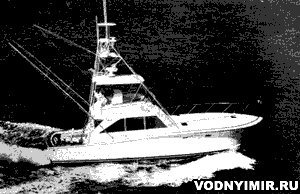 A large fishing boat is a motor yacht «Pacemaker-48» of the American company of the same name. Length — 14.7 m; width — 4.5. It has a soft stroke and moderate pitching. The area of the cockpit, sheathed in teak wood, is about 19 m. There is a door in the transom for lifting fish. The cockpit is also equipped with a refrigerator for bait, a crane beam, a control post, a pump for cleaning the deck. Additional control panels are available on the upper bridge and the tuna tower. The cabin is designed for 6-8 beds. The electric galley and refrigerators are powered by a generator. The fuel reserve for the diesel plant is 2650 liters. Cost $125,163. |
«Ocean racer and sea fisherman are now, perhaps, the favorites of boat builders», says Jim Wright, a columnist for the American magazine Rudder. As proof, he draws readers' attention to the fact that in the brochures of boat-building companies, already every second of the proposed models with a length of over 5.5 m is addressed to «fishermen». And, obviously, it is not by chance that specialized fishing boats have a steady sale, although their cost is significantly higher than the hulls of universal recreational and tourist models that differ practically little in characteristics!
The growth of popularity (primarily in the USA) of the «big fishing sport» — the so-called sport fishing of large fish with spinning tackle in the open sea — began in the late 50s, and the appearance of high-speed and seaworthy boats equipped with reliable engines largely contributed to this fishing boom. This is really a sport! An hour-long duel with a 300-kilogram tuna or swordfish requires a lot of physical endurance and composure from an athlete armed with a light spinning rod, gives great satisfaction — if an exciting fight ends in victory and unforgettable experiences in all cases.
Every year, the International Association of Sport Marine Fishing announces champions who have caught the largest fish under strictly defined conditions. They can be not only men: «The world record among women in shark fishing was set by Sydney resident Dapsi Chi: after a 5-hour struggle, she pulled out a tiger shark weighing 450 kg», we reprint this message from the newspaper Izvestia (February 5, 1977).
One of these champions was Ernest Hemingway. So, in 1939, he set a world record by catching off the coast of Bimini (Bahamas) a ferocious in attack and hardy in the struggle for life gray-blue shark-mako, which weighed 357 kg!
Numerous fishing clubs also hold special competitions. Sometimes the winners are awarded huge sums — up to 40-50 thousand dollars, but even if the only award is the right to perpetuate their name with an engraving on a rolling cup, the number of participants, despite the invariably solid entry fees (up to $ 200), as a rule, has to be limited. The catch caught after weighing by the judges is often immediately sold. For example, owners of Florida or California restaurants are happy to buy up trophies of «shark derby» — mako, valuing them up to $ 5 per inch in length.
What is the specifics of the big fishing sport, what problems does it pose to ship designers?
Looking for and chasing fish, anglers move away from the shore into the ocean sometimes up to 200 miles. Quickly reach your favorite place, find, catch up with a large fish (the speed of sharks, for example, reaches 37 km/h) and get away from it (the same sharks sometimes «rob» fishermen, driving away other fish, or even devouring the catch right on the hook) — you can only on a sufficiently fast vessel. Speed often becomes a decisive factor in fishing competitions. Here, for example, is what the shark derbies held regularly — twice a year — in Monterey Bay (California) look like. The start is given at 7.00: sometimes 140-150 powerful fishing boats rush into the ocean to moor at 13.00 — and not a minute later — and present the catch for weighing. (Sometimes the jury members had to weigh and compare 150 sharks and large rays each!). And very often the winner is the crew of the fastest vessel, who had more time for «clean fishing» by reducing losses on crossings...
Naturally, a fishing boat should develop high speed in real conditions of the open sea, which is rarely calm. That is why it was the lovers of sea fishing who were the first to appreciate the high seaworthiness of boats with contours of the deep V type and Raymond Hunt's «tridines», Richard Cope's «pulpits» and «airslots»!
It is also not indifferent how the boat behaves at low speed, for example, when a track with bait or artificial bait is towed astern. When the fish «bite», the boat should help the angler win the fight. Good maneuverability is required from the vessel. A fishing vessel should be well managed not only in the front, but also in the back, helping the athlete to choose the slack of nylon sand in time or anticipating the jerks of fish, which, by the way, has considerable strength: there is a case when a shark towed a 7-meter boat with a speed of up to 6 km/h for several hours!
It is important that the vessel is not felled and has a smooth pitching even on a large wave. And, of course, under all circumstances, the boat must be safe. There are also subtleties. For example, it is known that an angler sometimes has to circumvent the vessel several times around the perimeter, so free passages along the sides, powerful rails, etc. are needed on a fishing boat.
Modern marine fishing boats are conventionally divided into three types:
— small open boats with a central control station or, as it is commonly called, a console;
— open boats with a shelter cabin in the bow;
— large and comfortable cabin boats.
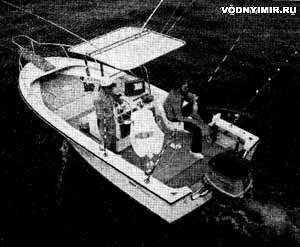 A small open-type fishing boat with a central console of the company «Slickcraft Boats» — «Robalo-190». Length — 5.8 m; width — 2.4 m; weight — 953 kg; fuel capacity — 227 liters; maximum outboard motor power — 200 hp. The boat has a raised fishing platform in the bow, a flat bowsprit; two soft fishing chairs, a shade canopy, two outriggers. The cost is $4490. |
Naturally, less expensive boats of the first type are most common, usually having a length of 4.9 to 7 m. They are popular on many large lakes (for example, on the Great Lakes), are widely used for fishing in sea bays and in the ocean, but with a limited distance from the shore — 10-20 miles.
Boats up to 5.5 m long with sharp-cheeked hulls and moderate keeling of the bottom 12-14° are being built for exits to lakes and sea bays; the cheekbone line rises in the nose to about the first third of the height of the side at the stem. On a relatively short wave of lakes or a broken wave in bays, boats with such hulls go gently. It makes sense to have a low cheekbone line and a full bow tip: when a fisherman with a spinning goes to the raised bow platform, the hull above the cheekbone is immersed in water and due to the increased waterline area, the vessel becomes more stable, there is not too much trim on the nose. Such hulls are usually equipped with one longitudinal redan, which is located approximately 2/3 of the width of the bottom from the DP to the side.
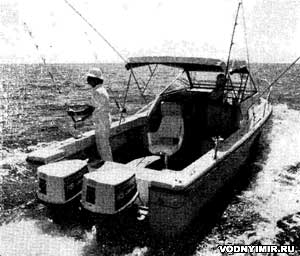 «Pocket» cruiser — fishing boat with cabin-shelter «Robalo-236» company «Slickcraft Boats». Length — 7 m; width — 2.4 m. Weight — 1300 kg. The fuel tank with a capacity of 317 liters is located in the «safety cell». Installation of outboard motors with a capacity of up to 250 hp is allowed. |
For fishing on ocean banks and shoals, larger boats with a length of 5.5 to 6.5 m are preferred. As a rule, the keeliness of the bottom on them is moderate — no more than 15-17°, since hulls with «real» contours of deep V would have a draft of 20-25 cm more, which in this case is undesirable.
Only on 6-7-meter boats designed for the open sea, the keel of the bottom is increased to 20° amidships, but on the transom it is reduced to the usual 12-14°. Hulls with deep V contours are also unacceptable for such conditions, but for another reason: they are too swollen in the parking lot and swing strongly at low speed.
It should be noted that there are no special «fishing» contours. Both conventional seaworthy sharp-cheeked boats with moderate keeling in the stern and boats with various modifications of trimaran contours are used. The designer first of all strives to create a spacious, stable and unsinkable «platform» for the angler, and then he is already thinking about how to make the boat go quickly through the agitated sea.
Now in the USA, 50 companies produce about 80 models of such «console» boats. With all the diversity, it is striking that the vast majority of them are 8 feet (2.44 m) wide or slightly less: the limitation of the size when transporting on a trailer affects. Boat manufacturers have reacted to market conditions: more and more «fishermen» refuse the high-cost services of private marinas, prefer to carry their vessel behind a car and store it in a garage.
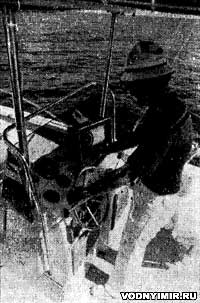 The center console of the fishing boat. The control panel contains devices for monitoring the operation of the engine and remote control of it. To the right of the driver, an electromagnetic log with a recorder is visible. The front of the console is equipped with a seat, under which a fish tank is made. A storm rail is placed around the smoky (polarized) windscreen. The mounting posts of the shade canopy are the bases of two outriggers. |
If it is difficult, or even impossible, to determine which fishing boat is and which is not by the contours and appearance of the hull itself (many companies produce cruising and pleasure boats in the same hull — for the weekend, and fishing options), then you can find out immediately by the layout of the boat for sea fishing. The most characteristic element of fishing boats of this type is the central console — the control panel. Standing on a raised platform in the center of a fully open vessel, the driver has a good all-round view, necessary for searching and chasing fish, as well as for maneuvering when the fish «took». The second advantage of such a layout is the possibility of unhindered circumvention of the angler around the console, complete freedom of his movement on the boat both during fishing and when taking out large fish. It is also worth noting that the idea of a «cantilever» boat was born in the south of the USA somewhere in the mid-60s. It is in the south, in the conditions of the subtropical climate of the same Florida, the cabin and, moreover, the cabin, which increases the cost of the boat, is not so necessary: it is enough to protect the driver with a windshield (often it is made smoky — to protect the eyes from glare) and a light canopy from the hot sun.
Another feature of «cantilever» fishing boats is the raised bow platform used for long-distance casting of spinning. The space under its flooring is used to equip all kinds of cabinets, racks and niches for storing fishing gear and equipment. A fishing boat is generally characterized by the most careful use of all available volumes. After all, one of the main commandments of the angler is that everything superfluous at the time of fishing should be removed from under his feet.
The flooring both on the bow platform and throughout the cockpit area is made «non-slip», as they say in the advertisement — «grabbing by the legs in stormy weather». On most boats, the cockpit is made self-draining, placing its bottom above the waterline and cutting drain scuppers in the sides and transom. Even a boat completely flooded with water remains practically unsinkable, since it is supplied with a sufficiently large margin of buoyancy in the form of foam located between the shells of the hull — in the inter-bottom space and along the sides along the entire perimeter of the hull.
The largest number of advertised fishing boats are built of fiberglass. The design of such vessels produced by the company «Slickcraft Boats» is characteristic. The case is glued manually from 12 layers of glass wool and roving. The skin is reinforced from the inside with a set of stringers molded to it. The inner shell — a deck with a cockpit and a platform — has a three-layer structure with a light balsa filler between layers of fiberglass. Such a three-layer structure has the necessary high rigidity with low weight, which is important for increasing the stability of the boat. This is usually facilitated by the placement of the built-in fuel tank in the inter-bottom space — under the bottom of the cockpit.
The designers' concern about stability can be understood, especially when you consider that now even the smallest 5-meter fishing boats are increasingly appearing fishnet tuna (or tuna) towers, previously considered a «monopoly» of large luxury vessels. From these «Eiffel towers» or «oil rigs», as the Americans call them, it is much easier to detect fish. For example, tuna is clearly visible from above, the rapid movement of the shark's dorsal fin is visible from afar. From the tower, it is better to see deep into the water, which helps the driver to maneuver the vessel correctly when the partner is busy taking out large fish.
Tuna derricks are usually made of light and durable pipes (aluminum alloy or stainless steel), another boat control post is equipped on the site — they put duplicate control and control devices for engine operation, and often a radio station, an echo sounder, etc. On boats with a central console, the tuna derrick usually has a height above the deck of about 3 m.
On some models of cantilever boats and on all larger vessels, soft fishing chairs are installed. In such a chair, the angler can even spend several hours at work without much fatigue. A hinged glass is usually attached to the front edge of the seat, into which the lower end of the spinning rod is inserted when fishing out fish. On the sides of the soft armrests there are glasses in which you can insert rods when fishing on the track. On small boats on the move, such chairs serve as an ordinary passenger seat.
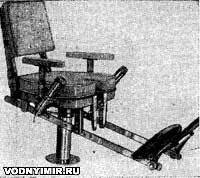 Combat chair for fights with especially large fish. |
«From 2000 kilograms of concentrated rage, Dean's hands turned into a bloody mess. Bubbles swelled and burst on his palms; his fingers, cut to the bone by the continuously twitching spinning, were numb with pain. My legs cramped. The muscles on his back were almost bursting with tension. And the battle lasted for the third hour... the fourth...» — this is how G. McCormick describes the fight against the white shark in his book «Shadows in the Sea» (translated into Russian in 1971). This fishing sport already has a lot in common with weightlifting. Therefore, for fights with especially large fish, special «combat chairs» are produced, allowing a significant part of the load to be perceived with legs, which, as is known, are stronger than hands. Such a chair, as a rule, has an adjustable backrest tilt and foot rests, movable by height. They move from a regular fishing chair to a combat chair when the fish is securely hooked and there is a long fight ahead. In order to stay in the chair with strong jerks of the fish, the athlete puts on a safety belt — a shoulder harness made of soft quilted leather; this belt also significantly unloads the muscles of the back and arms.
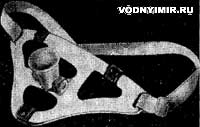 The adrenal harness is a fishing belt for the convenience of fixing the spinning rod when fishing out large fish. |
The fishing belt also helps, the so-called adrenal harness, which is a wide, durable apron with a hinged holder for spinning.
From afar, a modern fishing boat can be recognized by outriggers — rods with a length of at least 5 m for lateral fishing line removal when fishing on two (or more) tracks. For small vessels, folding outriggers, such as telescopic outriggers, are produced; on large boats they are similar to the mast of a yacht — they are loosened with braces and rigging, equipped with a device for automatically returning to the marching position.
The execution of all deck equipment and practical things (rail racks, for example) should exclude the possibility of catching the fishing line. For storing fish, removable fish boxes are equipped, which, with prolonged exits, can be replaced by ice coolers. Bait tanks are built into the transom.
Initially, cantilever boats were designed only for use with outboard motors. Now, in the total number of fishing vessels entering the market with a length of up to 7 m, at least an eighth of them are actually boats — vessels with stationary engines. For reliability, designers usually provide for the installation of two outboard motors, sometimes up to 150 hp each. It also matters that the two engines, turned on «vrazdrai», significantly improve the maneuverability of the vessel at low speeds of thrusting. While fishing on the track, one of the motors can be turned off: this reduces fuel consumption and reduces noise, which scares, for example, careful tuna. The maximum speed of small fishing boats often exceeds 35 knots; for example, the 6-meter «Boston Whaler» — «Outrage» with a 150-horsepower engine develops a speed of 38 knots (70 km/h).
The cost of fishing vessels with a central console — fully equipped, but without motors — ranges from $ 1,500 to $7,000.
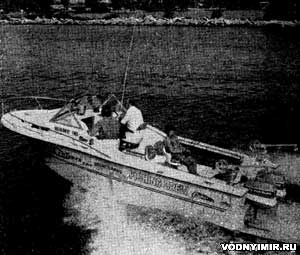 Fishing boat «Bonanza» company «Cruisers» with a cabin shelter. Length — 6.4 m; width — 2.4 m; weight with outboard motors up to 225 hp — 960 kg, with a stationary engine 233 hp — 1349 kg. There are two swivel chairs, two more in the cockpit for anglers; for storing the caught fish, two inset fish boxes are provided. |
Fishing boats of the second type, equipped with a shelter cabin with 2-3 sleeping places, are usually larger: their length is from 7 to 10 m. According to the contours and design of the hull, they differ little from cantilever vessels, but here the traditional control panel is already equipped on the starboard side. There is a widespread option with the location of an additional control post on the roof of the wheelhouse («flying bridge»), and to protect the driver, a rigid awning is often made over it with rails around the perimeter. X. Baader in his book «Traveling, tourist and sports boats» (publishing house «Shipbuilding», 1977) provides a general layout and basic data of a typical version of such a boat «Barracuda» (length 8.6 m with a width of 3.2 m; speed when installing two 185-horsepower engines — up to 31 uz or 57 km/h).
Naturally, on such boats more often than on console boats, you can see tuna towers, combat chairs, cages for live bait, crane beams for lifting large fish.
These boats are most often equipped with stationary engines with angular columns. For example, one 280-horsepower or two 140-horsepower gasoline engines with corner columns «Mercruiser» are installed on the popular model of the 24-foot «Airslot» of the American company «Wellcraft». The vessel can easily reach speeds of up to 37.8 knots (70 km/h). The cost of this boat is over 10 thousand dollars.
The appearance of light diesels has significantly changed the situation with the choice of power plants for medium and large fishing boats. If earlier the use of diesel engines on a boat with a length of 10.7 m was associated with a significant increase in the weight of the vessel and a decrease in speed, now diesel engines are installed even on boats with a length of 7.3 m. The specific weight of the best diesel engines with a capacity of 200-300 hp reaches 3-3.2 kg/hp boats with such diesel installations have an increased cruising range (sometimes over 700 miles), are more economical and at the same time develop speeds up to 40 knots (74 km/h).
For example, an average fishing 24-foot boat «Black Fin» («Black Fin») with a diesel engine «Caterpillar-3208» with a capacity of 225 hp can go for a long time at a speed of 34 knots (63 km/h), consuming 27.3 liters of fuel per hour. And exactly the same boat with two gasoline engines develops speeds of up to 38.8 km/h (72.5 km/h) at a much more expensive fuel consumption of up to 55 liters/h. The cost of a «Black Fin» with gasoline engines and a corner column is $ 15,900, and with a diesel engine — $ 27,990; as you can see, economical and reliable diesel engines are still very expensive!
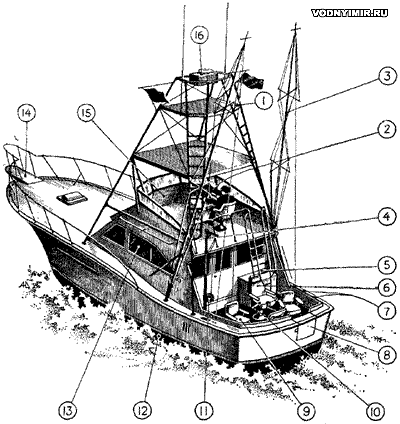 The general location of a large fishing boat. 1 — tuna rig; 2 — control post on the upper bridge; 3 — outriggers; 4 — crane-beam for lifting fish on board; 5 — freezer for bait; 6 — combat chair; 7 — spinning holders; 8 — transom door; 9 — fishing an armchair; 10 — a glass holder for a fishing rod; 11 — a control post in the cockpit; 12 — an echo sounder (not visible); 13 — a wheelhouse with a central control post; 14 — a flat bowsprit; 15 — an upper bridge; 16 — a control panel on a tuna rig. |
Vessels of the third type — cabin boats, the length of which exceeds 10 m, can confidently move into the ocean 150-200 miles from the shore. The ratio of length to width of the hull is usually in the range of 2.6-3.1. Some boats, for example, the 13-meter «No problem» company «Merrit», are equipped with the simplest rocking calms (such as «flopper-stopper» — with two plates towed by means of side arrows — «paravans»). Sharp-cheeked contours with a significant keeling of the bottom in the middle — up to 23°, on the transom decreasing to 9-12° allow you to have a relatively soft ride on the wave at speeds of 27-32 knots (50-60 km/h). As a feature, it can be noted that most boats have a rounded shape of the stern in terms of: this significantly improves maneuverability in reverse at low taxiing speed, such a transom shape is also advantageous for strength reasons.
Most even large boats of the type in question are built of fiberglass, widely using three-layer «sandwich» structures. As a rule, the traditional scheme of reinforcement of the skin with molded stringers, frames and bulkheads is used.
Large fishing boats are equipped mainly with diesel installations. For example, two 400 hp diesel engines are installed on the above-mentioned Merrit boat. With the help of which it can easily maintain a speed of 27.5 knots (52 km/h) even on a 1.5-meter wave.
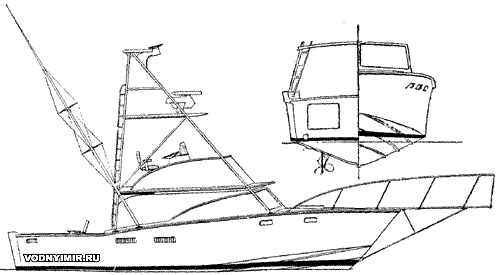 Eleven-meter fishing boat of the company «Broadbill». Deep-keeled contours (23°) allow you to maintain speeds of up to 32 knots (59.3 km/h) in the open sea (under a 432-horsepower diesel engine). |
A mandatory accessory of these boats is a tuna rig. Their height sometimes reaches 9-10 m, and the total number of additional control panels on different floors of the tower reaches four.
Anglers are usually located in the stern. Here, a «non-slip» flooring covering and a soft belt — a safety strip at the height of a person's knees along the entire perimeter of the bulwark or railing are mandatory. Combat chairs and a crane-beam with a lifting capacity of up to 500 kg are installed here: a caught shark is usually suspended — necessarily overboard and head down (a shark, even stunned, is very dangerous).
A characteristic feature of large boats is the «pulpit» or «balcony» — a bowsprit-a platform with a rigid railing, from which it is convenient to take out fish; it turns out to be useful when mooring a boat. To drag large fish onto the deck, an inclined slip platform is often made in the stern; the hole in the transom is closed with doors on the move.
To preserve the catch, all boats are equipped with spacious refrigerators and freezers. A small freezer for storing bait is often installed directly in the cockpit. Under the cockpit flooring, one or two large cages for caught fish and a bait tank are usually equipped, a place for storing special separator shields is protected, which separate one part of the fish cargo from another. Under the faceplate along the sides, you can see built-in cabinets for spinning rods, hooks and other equipment that should be at hand. Often on such boats, a shkering table (with a sink) is also installed for cutting fish.
Much attention is paid to the equipment of the boat with the necessary devices for the angler. In particular, all boats are equipped with fishing equipment. There are three types of hydroacoustic devices for this purpose (with a scale and a flashing pointer or with a recorder); the angler has accurate data on the configuration of the bottom and depths under the keel, on the appearance of shoals or individual large fish.
The equipment of the long-range radio navigation system «Loran», previously used only on large vessels, is now increasingly appearing on fishing boats, especially those that operate in difficult navigational conditions areas — among reefs, cans, etc. These devices give a real opportunity to get exactly to your favorite fishing spot.
VHF radiotelephone stations are widely used on fishing boats as a means of communication of a limited range.
A large sea fishing boat is always a fashionable motor yacht, which is equipped with not one, but several cabins and a salon with air conditioning, a galley, a shower, etc. Depending on the quality of the finish, the level of comfort and completeness of the equipment set, the cost of the boat ranges from 20 thousand (Spartan is a purely sports option with only the most necessary devices) to 500 thousand dollars.
In the section «Motorboats, boats, yachts — miscellaneous, reviews, tips»
Share this page in the social. networks or bookmark:
